Psychology of Health and Illness: Media's Effect on Body Image
VerifiedAdded on 2021/05/27
|8
|2934
|103
Essay
AI Summary
This essay delves into the psychology of health and illness, specifically examining how media influences body image and contributes to eating disorders. It synthesizes research from various studies to highlight the pervasive impact of media portrayals on women's perceptions of their bodies. The essay discusses how media-driven ideals of thinness lead to body dissatisfaction, disordered eating behaviors, and related health issues. It references key theories such as the Health Belief Model and the Theory of Planned Behavior to explain the psychological mechanisms at play. The essay also explores the role of ethnicity, magazine readership, and television viewing habits in shaping body image perceptions, ultimately concluding that media significantly contributes to unrealistic body expectations and harmful health outcomes. Desklib provides this essay and other resources to aid students in their studies.

Running Head: Psychology of Health and Illness
Psychology of Health and Illness
Psychology of Health and Illness
Paraphrase This Document
Need a fresh take? Get an instant paraphrase of this document with our AI Paraphraser
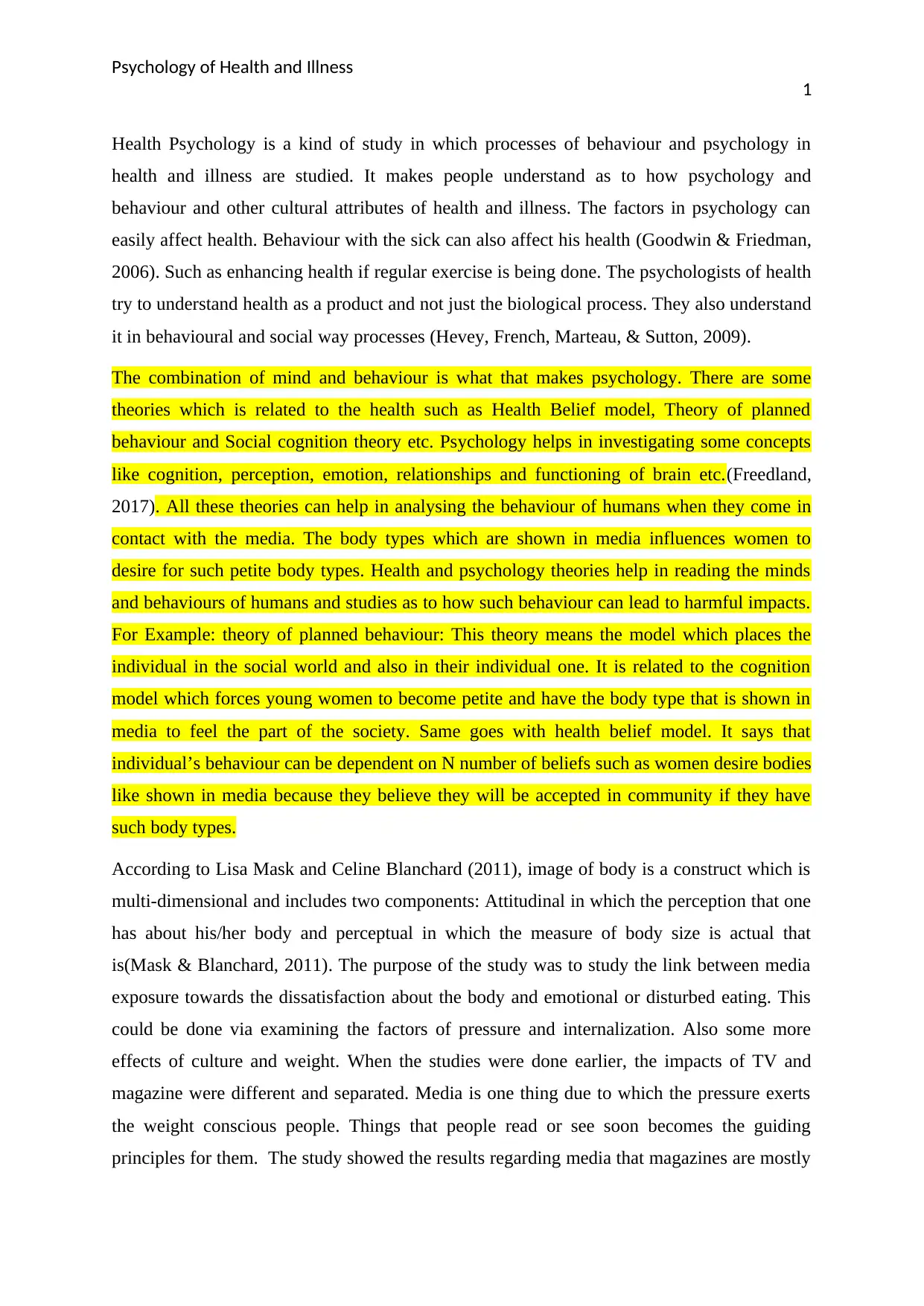
Psychology of Health and Illness
1
Health Psychology is a kind of study in which processes of behaviour and psychology in
health and illness are studied. It makes people understand as to how psychology and
behaviour and other cultural attributes of health and illness. The factors in psychology can
easily affect health. Behaviour with the sick can also affect his health (Goodwin & Friedman,
2006). Such as enhancing health if regular exercise is being done. The psychologists of health
try to understand health as a product and not just the biological process. They also understand
it in behavioural and social way processes (Hevey, French, Marteau, & Sutton, 2009).
The combination of mind and behaviour is what that makes psychology. There are some
theories which is related to the health such as Health Belief model, Theory of planned
behaviour and Social cognition theory etc. Psychology helps in investigating some concepts
like cognition, perception, emotion, relationships and functioning of brain etc.(Freedland,
2017). All these theories can help in analysing the behaviour of humans when they come in
contact with the media. The body types which are shown in media influences women to
desire for such petite body types. Health and psychology theories help in reading the minds
and behaviours of humans and studies as to how such behaviour can lead to harmful impacts.
For Example: theory of planned behaviour: This theory means the model which places the
individual in the social world and also in their individual one. It is related to the cognition
model which forces young women to become petite and have the body type that is shown in
media to feel the part of the society. Same goes with health belief model. It says that
individual’s behaviour can be dependent on N number of beliefs such as women desire bodies
like shown in media because they believe they will be accepted in community if they have
such body types.
According to Lisa Mask and Celine Blanchard (2011), image of body is a construct which is
multi-dimensional and includes two components: Attitudinal in which the perception that one
has about his/her body and perceptual in which the measure of body size is actual that
is(Mask & Blanchard, 2011). The purpose of the study was to study the link between media
exposure towards the dissatisfaction about the body and emotional or disturbed eating. This
could be done via examining the factors of pressure and internalization. Also some more
effects of culture and weight. When the studies were done earlier, the impacts of TV and
magazine were different and separated. Media is one thing due to which the pressure exerts
the weight conscious people. Things that people read or see soon becomes the guiding
principles for them. The study showed the results regarding media that magazines are mostly
1
Health Psychology is a kind of study in which processes of behaviour and psychology in
health and illness are studied. It makes people understand as to how psychology and
behaviour and other cultural attributes of health and illness. The factors in psychology can
easily affect health. Behaviour with the sick can also affect his health (Goodwin & Friedman,
2006). Such as enhancing health if regular exercise is being done. The psychologists of health
try to understand health as a product and not just the biological process. They also understand
it in behavioural and social way processes (Hevey, French, Marteau, & Sutton, 2009).
The combination of mind and behaviour is what that makes psychology. There are some
theories which is related to the health such as Health Belief model, Theory of planned
behaviour and Social cognition theory etc. Psychology helps in investigating some concepts
like cognition, perception, emotion, relationships and functioning of brain etc.(Freedland,
2017). All these theories can help in analysing the behaviour of humans when they come in
contact with the media. The body types which are shown in media influences women to
desire for such petite body types. Health and psychology theories help in reading the minds
and behaviours of humans and studies as to how such behaviour can lead to harmful impacts.
For Example: theory of planned behaviour: This theory means the model which places the
individual in the social world and also in their individual one. It is related to the cognition
model which forces young women to become petite and have the body type that is shown in
media to feel the part of the society. Same goes with health belief model. It says that
individual’s behaviour can be dependent on N number of beliefs such as women desire bodies
like shown in media because they believe they will be accepted in community if they have
such body types.
According to Lisa Mask and Celine Blanchard (2011), image of body is a construct which is
multi-dimensional and includes two components: Attitudinal in which the perception that one
has about his/her body and perceptual in which the measure of body size is actual that
is(Mask & Blanchard, 2011). The purpose of the study was to study the link between media
exposure towards the dissatisfaction about the body and emotional or disturbed eating. This
could be done via examining the factors of pressure and internalization. Also some more
effects of culture and weight. When the studies were done earlier, the impacts of TV and
magazine were different and separated. Media is one thing due to which the pressure exerts
the weight conscious people. Things that people read or see soon becomes the guiding
principles for them. The study showed the results regarding media that magazines are mostly
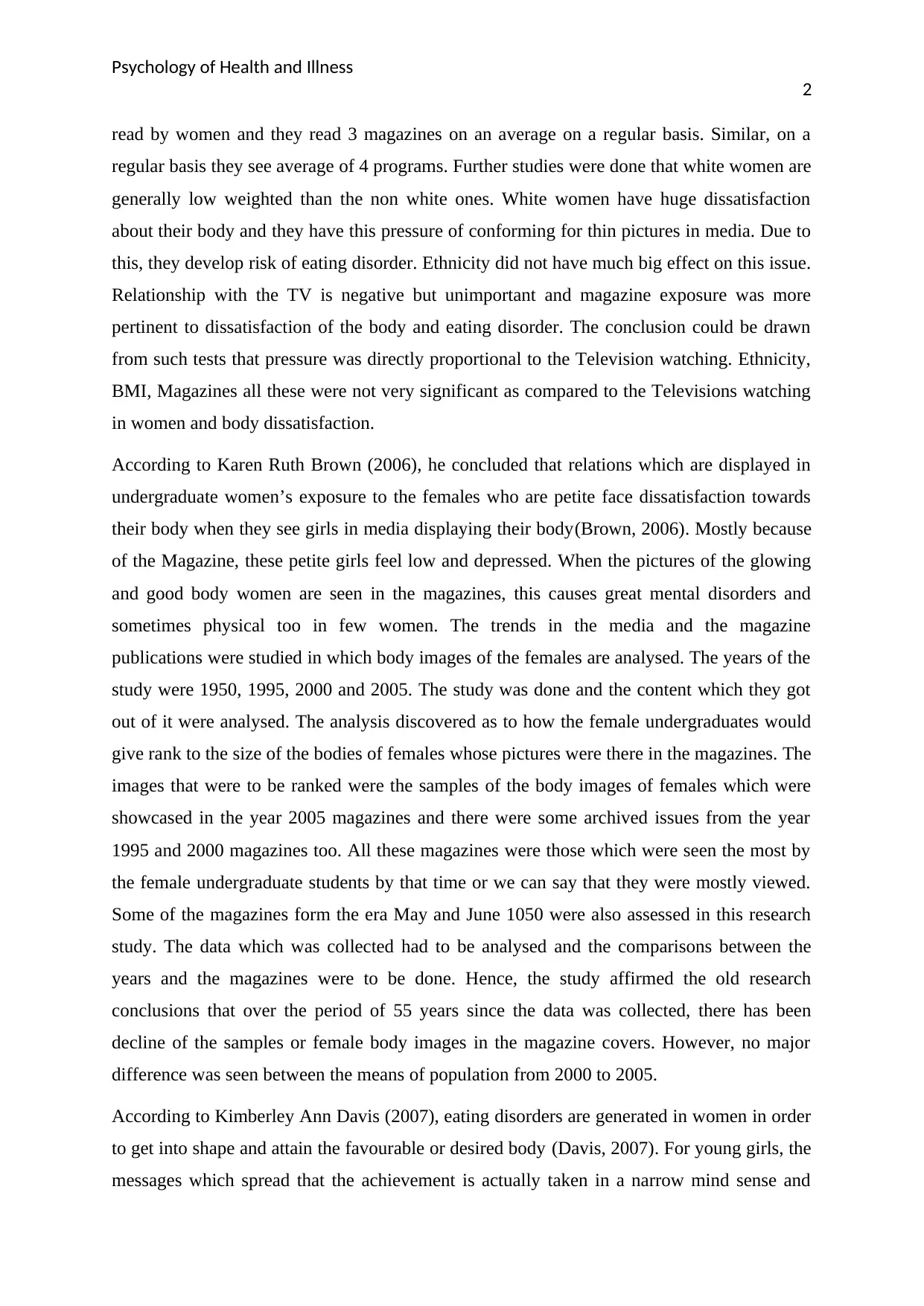
Psychology of Health and Illness
2
read by women and they read 3 magazines on an average on a regular basis. Similar, on a
regular basis they see average of 4 programs. Further studies were done that white women are
generally low weighted than the non white ones. White women have huge dissatisfaction
about their body and they have this pressure of conforming for thin pictures in media. Due to
this, they develop risk of eating disorder. Ethnicity did not have much big effect on this issue.
Relationship with the TV is negative but unimportant and magazine exposure was more
pertinent to dissatisfaction of the body and eating disorder. The conclusion could be drawn
from such tests that pressure was directly proportional to the Television watching. Ethnicity,
BMI, Magazines all these were not very significant as compared to the Televisions watching
in women and body dissatisfaction.
According to Karen Ruth Brown (2006), he concluded that relations which are displayed in
undergraduate women’s exposure to the females who are petite face dissatisfaction towards
their body when they see girls in media displaying their body(Brown, 2006). Mostly because
of the Magazine, these petite girls feel low and depressed. When the pictures of the glowing
and good body women are seen in the magazines, this causes great mental disorders and
sometimes physical too in few women. The trends in the media and the magazine
publications were studied in which body images of the females are analysed. The years of the
study were 1950, 1995, 2000 and 2005. The study was done and the content which they got
out of it were analysed. The analysis discovered as to how the female undergraduates would
give rank to the size of the bodies of females whose pictures were there in the magazines. The
images that were to be ranked were the samples of the body images of females which were
showcased in the year 2005 magazines and there were some archived issues from the year
1995 and 2000 magazines too. All these magazines were those which were seen the most by
the female undergraduate students by that time or we can say that they were mostly viewed.
Some of the magazines form the era May and June 1050 were also assessed in this research
study. The data which was collected had to be analysed and the comparisons between the
years and the magazines were to be done. Hence, the study affirmed the old research
conclusions that over the period of 55 years since the data was collected, there has been
decline of the samples or female body images in the magazine covers. However, no major
difference was seen between the means of population from 2000 to 2005.
According to Kimberley Ann Davis (2007), eating disorders are generated in women in order
to get into shape and attain the favourable or desired body (Davis, 2007). For young girls, the
messages which spread that the achievement is actually taken in a narrow mind sense and
2
read by women and they read 3 magazines on an average on a regular basis. Similar, on a
regular basis they see average of 4 programs. Further studies were done that white women are
generally low weighted than the non white ones. White women have huge dissatisfaction
about their body and they have this pressure of conforming for thin pictures in media. Due to
this, they develop risk of eating disorder. Ethnicity did not have much big effect on this issue.
Relationship with the TV is negative but unimportant and magazine exposure was more
pertinent to dissatisfaction of the body and eating disorder. The conclusion could be drawn
from such tests that pressure was directly proportional to the Television watching. Ethnicity,
BMI, Magazines all these were not very significant as compared to the Televisions watching
in women and body dissatisfaction.
According to Karen Ruth Brown (2006), he concluded that relations which are displayed in
undergraduate women’s exposure to the females who are petite face dissatisfaction towards
their body when they see girls in media displaying their body(Brown, 2006). Mostly because
of the Magazine, these petite girls feel low and depressed. When the pictures of the glowing
and good body women are seen in the magazines, this causes great mental disorders and
sometimes physical too in few women. The trends in the media and the magazine
publications were studied in which body images of the females are analysed. The years of the
study were 1950, 1995, 2000 and 2005. The study was done and the content which they got
out of it were analysed. The analysis discovered as to how the female undergraduates would
give rank to the size of the bodies of females whose pictures were there in the magazines. The
images that were to be ranked were the samples of the body images of females which were
showcased in the year 2005 magazines and there were some archived issues from the year
1995 and 2000 magazines too. All these magazines were those which were seen the most by
the female undergraduate students by that time or we can say that they were mostly viewed.
Some of the magazines form the era May and June 1050 were also assessed in this research
study. The data which was collected had to be analysed and the comparisons between the
years and the magazines were to be done. Hence, the study affirmed the old research
conclusions that over the period of 55 years since the data was collected, there has been
decline of the samples or female body images in the magazine covers. However, no major
difference was seen between the means of population from 2000 to 2005.
According to Kimberley Ann Davis (2007), eating disorders are generated in women in order
to get into shape and attain the favourable or desired body (Davis, 2007). For young girls, the
messages which spread that the achievement is actually taken in a narrow mind sense and
⊘ This is a preview!⊘
Do you want full access?
Subscribe today to unlock all pages.

Trusted by 1+ million students worldwide
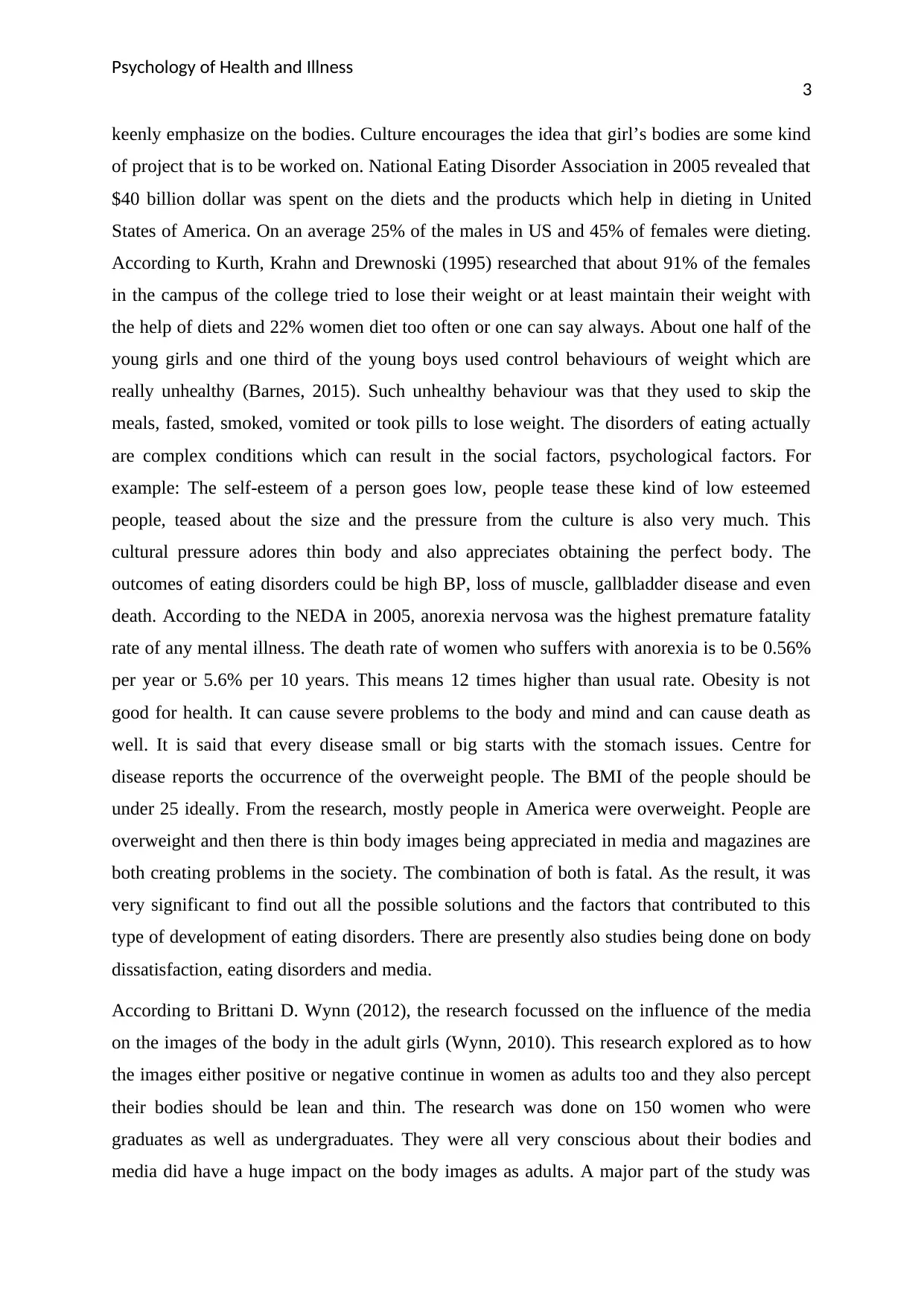
Psychology of Health and Illness
3
keenly emphasize on the bodies. Culture encourages the idea that girl’s bodies are some kind
of project that is to be worked on. National Eating Disorder Association in 2005 revealed that
$40 billion dollar was spent on the diets and the products which help in dieting in United
States of America. On an average 25% of the males in US and 45% of females were dieting.
According to Kurth, Krahn and Drewnoski (1995) researched that about 91% of the females
in the campus of the college tried to lose their weight or at least maintain their weight with
the help of diets and 22% women diet too often or one can say always. About one half of the
young girls and one third of the young boys used control behaviours of weight which are
really unhealthy (Barnes, 2015). Such unhealthy behaviour was that they used to skip the
meals, fasted, smoked, vomited or took pills to lose weight. The disorders of eating actually
are complex conditions which can result in the social factors, psychological factors. For
example: The self-esteem of a person goes low, people tease these kind of low esteemed
people, teased about the size and the pressure from the culture is also very much. This
cultural pressure adores thin body and also appreciates obtaining the perfect body. The
outcomes of eating disorders could be high BP, loss of muscle, gallbladder disease and even
death. According to the NEDA in 2005, anorexia nervosa was the highest premature fatality
rate of any mental illness. The death rate of women who suffers with anorexia is to be 0.56%
per year or 5.6% per 10 years. This means 12 times higher than usual rate. Obesity is not
good for health. It can cause severe problems to the body and mind and can cause death as
well. It is said that every disease small or big starts with the stomach issues. Centre for
disease reports the occurrence of the overweight people. The BMI of the people should be
under 25 ideally. From the research, mostly people in America were overweight. People are
overweight and then there is thin body images being appreciated in media and magazines are
both creating problems in the society. The combination of both is fatal. As the result, it was
very significant to find out all the possible solutions and the factors that contributed to this
type of development of eating disorders. There are presently also studies being done on body
dissatisfaction, eating disorders and media.
According to Brittani D. Wynn (2012), the research focussed on the influence of the media
on the images of the body in the adult girls (Wynn, 2010). This research explored as to how
the images either positive or negative continue in women as adults too and they also percept
their bodies should be lean and thin. The research was done on 150 women who were
graduates as well as undergraduates. They were all very conscious about their bodies and
media did have a huge impact on the body images as adults. A major part of the study was
3
keenly emphasize on the bodies. Culture encourages the idea that girl’s bodies are some kind
of project that is to be worked on. National Eating Disorder Association in 2005 revealed that
$40 billion dollar was spent on the diets and the products which help in dieting in United
States of America. On an average 25% of the males in US and 45% of females were dieting.
According to Kurth, Krahn and Drewnoski (1995) researched that about 91% of the females
in the campus of the college tried to lose their weight or at least maintain their weight with
the help of diets and 22% women diet too often or one can say always. About one half of the
young girls and one third of the young boys used control behaviours of weight which are
really unhealthy (Barnes, 2015). Such unhealthy behaviour was that they used to skip the
meals, fasted, smoked, vomited or took pills to lose weight. The disorders of eating actually
are complex conditions which can result in the social factors, psychological factors. For
example: The self-esteem of a person goes low, people tease these kind of low esteemed
people, teased about the size and the pressure from the culture is also very much. This
cultural pressure adores thin body and also appreciates obtaining the perfect body. The
outcomes of eating disorders could be high BP, loss of muscle, gallbladder disease and even
death. According to the NEDA in 2005, anorexia nervosa was the highest premature fatality
rate of any mental illness. The death rate of women who suffers with anorexia is to be 0.56%
per year or 5.6% per 10 years. This means 12 times higher than usual rate. Obesity is not
good for health. It can cause severe problems to the body and mind and can cause death as
well. It is said that every disease small or big starts with the stomach issues. Centre for
disease reports the occurrence of the overweight people. The BMI of the people should be
under 25 ideally. From the research, mostly people in America were overweight. People are
overweight and then there is thin body images being appreciated in media and magazines are
both creating problems in the society. The combination of both is fatal. As the result, it was
very significant to find out all the possible solutions and the factors that contributed to this
type of development of eating disorders. There are presently also studies being done on body
dissatisfaction, eating disorders and media.
According to Brittani D. Wynn (2012), the research focussed on the influence of the media
on the images of the body in the adult girls (Wynn, 2010). This research explored as to how
the images either positive or negative continue in women as adults too and they also percept
their bodies should be lean and thin. The research was done on 150 women who were
graduates as well as undergraduates. They were all very conscious about their bodies and
media did have a huge impact on the body images as adults. A major part of the study was
Paraphrase This Document
Need a fresh take? Get an instant paraphrase of this document with our AI Paraphraser
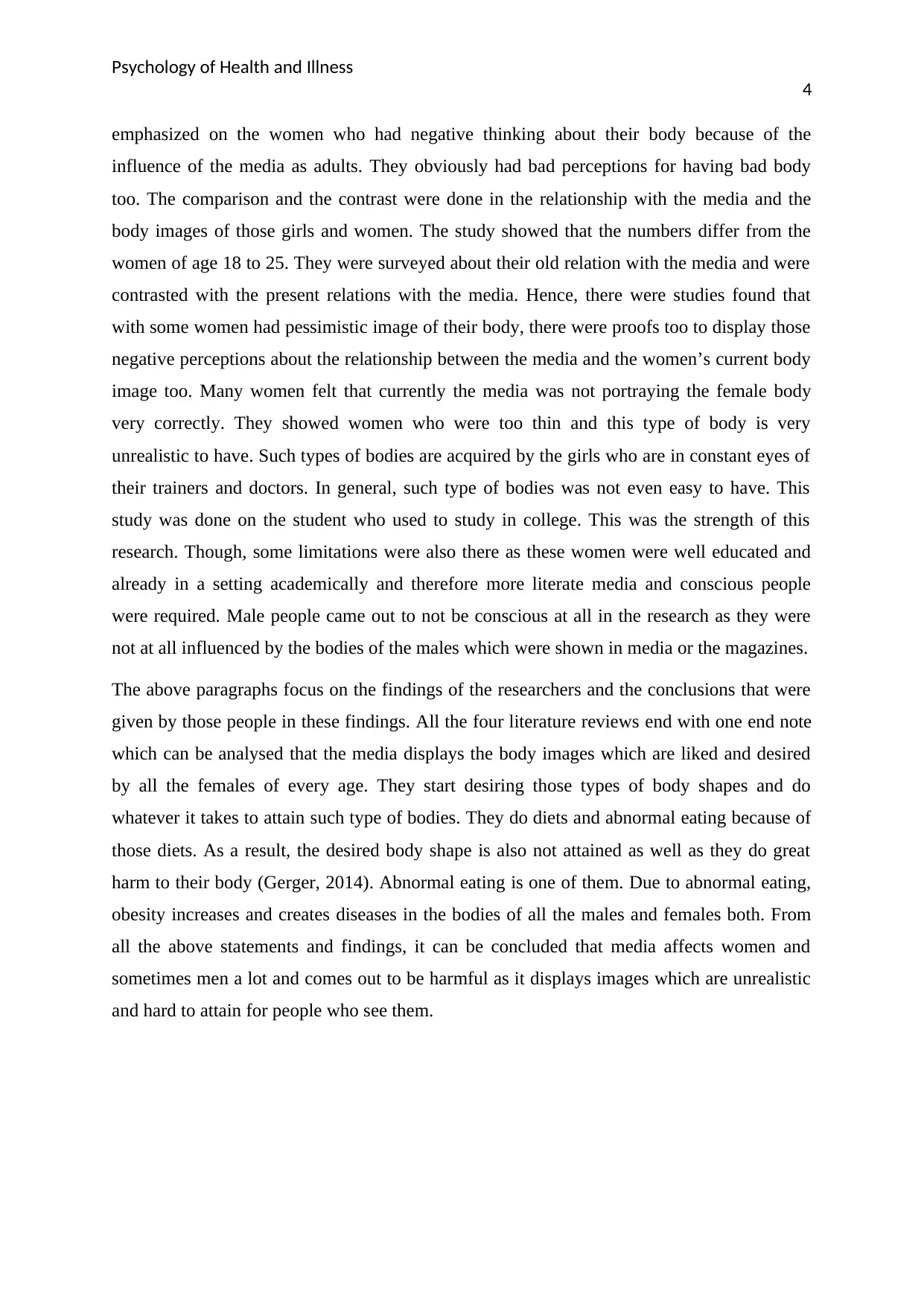
Psychology of Health and Illness
4
emphasized on the women who had negative thinking about their body because of the
influence of the media as adults. They obviously had bad perceptions for having bad body
too. The comparison and the contrast were done in the relationship with the media and the
body images of those girls and women. The study showed that the numbers differ from the
women of age 18 to 25. They were surveyed about their old relation with the media and were
contrasted with the present relations with the media. Hence, there were studies found that
with some women had pessimistic image of their body, there were proofs too to display those
negative perceptions about the relationship between the media and the women’s current body
image too. Many women felt that currently the media was not portraying the female body
very correctly. They showed women who were too thin and this type of body is very
unrealistic to have. Such types of bodies are acquired by the girls who are in constant eyes of
their trainers and doctors. In general, such type of bodies was not even easy to have. This
study was done on the student who used to study in college. This was the strength of this
research. Though, some limitations were also there as these women were well educated and
already in a setting academically and therefore more literate media and conscious people
were required. Male people came out to not be conscious at all in the research as they were
not at all influenced by the bodies of the males which were shown in media or the magazines.
The above paragraphs focus on the findings of the researchers and the conclusions that were
given by those people in these findings. All the four literature reviews end with one end note
which can be analysed that the media displays the body images which are liked and desired
by all the females of every age. They start desiring those types of body shapes and do
whatever it takes to attain such type of bodies. They do diets and abnormal eating because of
those diets. As a result, the desired body shape is also not attained as well as they do great
harm to their body (Gerger, 2014). Abnormal eating is one of them. Due to abnormal eating,
obesity increases and creates diseases in the bodies of all the males and females both. From
all the above statements and findings, it can be concluded that media affects women and
sometimes men a lot and comes out to be harmful as it displays images which are unrealistic
and hard to attain for people who see them.
4
emphasized on the women who had negative thinking about their body because of the
influence of the media as adults. They obviously had bad perceptions for having bad body
too. The comparison and the contrast were done in the relationship with the media and the
body images of those girls and women. The study showed that the numbers differ from the
women of age 18 to 25. They were surveyed about their old relation with the media and were
contrasted with the present relations with the media. Hence, there were studies found that
with some women had pessimistic image of their body, there were proofs too to display those
negative perceptions about the relationship between the media and the women’s current body
image too. Many women felt that currently the media was not portraying the female body
very correctly. They showed women who were too thin and this type of body is very
unrealistic to have. Such types of bodies are acquired by the girls who are in constant eyes of
their trainers and doctors. In general, such type of bodies was not even easy to have. This
study was done on the student who used to study in college. This was the strength of this
research. Though, some limitations were also there as these women were well educated and
already in a setting academically and therefore more literate media and conscious people
were required. Male people came out to not be conscious at all in the research as they were
not at all influenced by the bodies of the males which were shown in media or the magazines.
The above paragraphs focus on the findings of the researchers and the conclusions that were
given by those people in these findings. All the four literature reviews end with one end note
which can be analysed that the media displays the body images which are liked and desired
by all the females of every age. They start desiring those types of body shapes and do
whatever it takes to attain such type of bodies. They do diets and abnormal eating because of
those diets. As a result, the desired body shape is also not attained as well as they do great
harm to their body (Gerger, 2014). Abnormal eating is one of them. Due to abnormal eating,
obesity increases and creates diseases in the bodies of all the males and females both. From
all the above statements and findings, it can be concluded that media affects women and
sometimes men a lot and comes out to be harmful as it displays images which are unrealistic
and hard to attain for people who see them.

Psychology of Health and Illness
5
5
⊘ This is a preview!⊘
Do you want full access?
Subscribe today to unlock all pages.

Trusted by 1+ million students worldwide
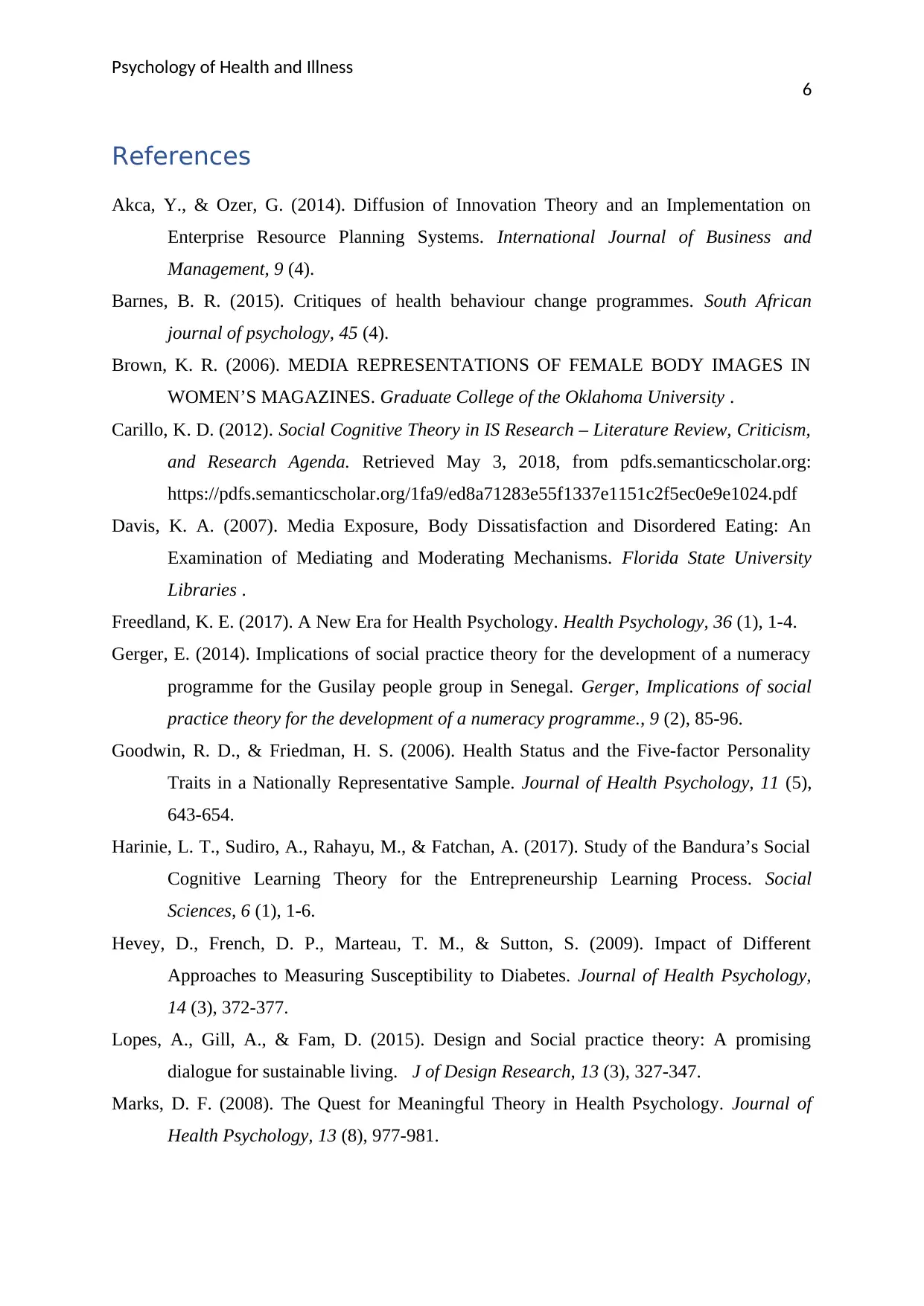
Psychology of Health and Illness
6
References
Akca, Y., & Ozer, G. (2014). Diffusion of Innovation Theory and an Implementation on
Enterprise Resource Planning Systems. International Journal of Business and
Management, 9 (4).
Barnes, B. R. (2015). Critiques of health behaviour change programmes. South African
journal of psychology, 45 (4).
Brown, K. R. (2006). MEDIA REPRESENTATIONS OF FEMALE BODY IMAGES IN
WOMEN’S MAGAZINES. Graduate College of the Oklahoma University .
Carillo, K. D. (2012). Social Cognitive Theory in IS Research – Literature Review, Criticism,
and Research Agenda. Retrieved May 3, 2018, from pdfs.semanticscholar.org:
https://pdfs.semanticscholar.org/1fa9/ed8a71283e55f1337e1151c2f5ec0e9e1024.pdf
Davis, K. A. (2007). Media Exposure, Body Dissatisfaction and Disordered Eating: An
Examination of Mediating and Moderating Mechanisms. Florida State University
Libraries .
Freedland, K. E. (2017). A New Era for Health Psychology. Health Psychology, 36 (1), 1-4.
Gerger, E. (2014). Implications of social practice theory for the development of a numeracy
programme for the Gusilay people group in Senegal. Gerger, Implications of social
practice theory for the development of a numeracy programme., 9 (2), 85-96.
Goodwin, R. D., & Friedman, H. S. (2006). Health Status and the Five-factor Personality
Traits in a Nationally Representative Sample. Journal of Health Psychology, 11 (5),
643-654.
Harinie, L. T., Sudiro, A., Rahayu, M., & Fatchan, A. (2017). Study of the Bandura’s Social
Cognitive Learning Theory for the Entrepreneurship Learning Process. Social
Sciences, 6 (1), 1-6.
Hevey, D., French, D. P., Marteau, T. M., & Sutton, S. (2009). Impact of Different
Approaches to Measuring Susceptibility to Diabetes. Journal of Health Psychology,
14 (3), 372-377.
Lopes, A., Gill, A., & Fam, D. (2015). Design and Social practice theory: A promising
dialogue for sustainable living. J of Design Research, 13 (3), 327-347.
Marks, D. F. (2008). The Quest for Meaningful Theory in Health Psychology. Journal of
Health Psychology, 13 (8), 977-981.
6
References
Akca, Y., & Ozer, G. (2014). Diffusion of Innovation Theory and an Implementation on
Enterprise Resource Planning Systems. International Journal of Business and
Management, 9 (4).
Barnes, B. R. (2015). Critiques of health behaviour change programmes. South African
journal of psychology, 45 (4).
Brown, K. R. (2006). MEDIA REPRESENTATIONS OF FEMALE BODY IMAGES IN
WOMEN’S MAGAZINES. Graduate College of the Oklahoma University .
Carillo, K. D. (2012). Social Cognitive Theory in IS Research – Literature Review, Criticism,
and Research Agenda. Retrieved May 3, 2018, from pdfs.semanticscholar.org:
https://pdfs.semanticscholar.org/1fa9/ed8a71283e55f1337e1151c2f5ec0e9e1024.pdf
Davis, K. A. (2007). Media Exposure, Body Dissatisfaction and Disordered Eating: An
Examination of Mediating and Moderating Mechanisms. Florida State University
Libraries .
Freedland, K. E. (2017). A New Era for Health Psychology. Health Psychology, 36 (1), 1-4.
Gerger, E. (2014). Implications of social practice theory for the development of a numeracy
programme for the Gusilay people group in Senegal. Gerger, Implications of social
practice theory for the development of a numeracy programme., 9 (2), 85-96.
Goodwin, R. D., & Friedman, H. S. (2006). Health Status and the Five-factor Personality
Traits in a Nationally Representative Sample. Journal of Health Psychology, 11 (5),
643-654.
Harinie, L. T., Sudiro, A., Rahayu, M., & Fatchan, A. (2017). Study of the Bandura’s Social
Cognitive Learning Theory for the Entrepreneurship Learning Process. Social
Sciences, 6 (1), 1-6.
Hevey, D., French, D. P., Marteau, T. M., & Sutton, S. (2009). Impact of Different
Approaches to Measuring Susceptibility to Diabetes. Journal of Health Psychology,
14 (3), 372-377.
Lopes, A., Gill, A., & Fam, D. (2015). Design and Social practice theory: A promising
dialogue for sustainable living. J of Design Research, 13 (3), 327-347.
Marks, D. F. (2008). The Quest for Meaningful Theory in Health Psychology. Journal of
Health Psychology, 13 (8), 977-981.
Paraphrase This Document
Need a fresh take? Get an instant paraphrase of this document with our AI Paraphraser
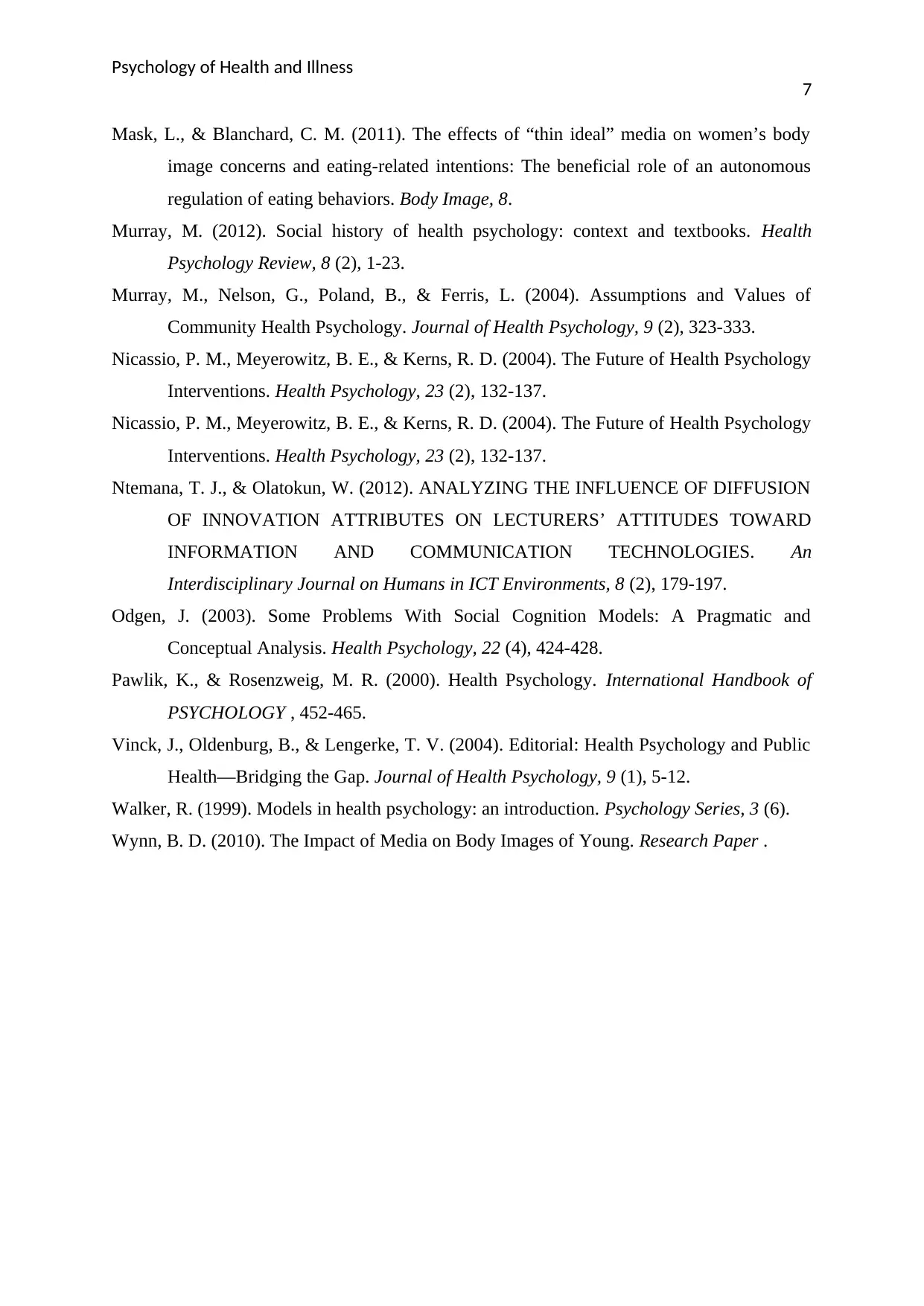
Psychology of Health and Illness
7
Mask, L., & Blanchard, C. M. (2011). The effects of “thin ideal” media on women’s body
image concerns and eating-related intentions: The beneficial role of an autonomous
regulation of eating behaviors. Body Image, 8.
Murray, M. (2012). Social history of health psychology: context and textbooks. Health
Psychology Review, 8 (2), 1-23.
Murray, M., Nelson, G., Poland, B., & Ferris, L. (2004). Assumptions and Values of
Community Health Psychology. Journal of Health Psychology, 9 (2), 323-333.
Nicassio, P. M., Meyerowitz, B. E., & Kerns, R. D. (2004). The Future of Health Psychology
Interventions. Health Psychology, 23 (2), 132-137.
Nicassio, P. M., Meyerowitz, B. E., & Kerns, R. D. (2004). The Future of Health Psychology
Interventions. Health Psychology, 23 (2), 132-137.
Ntemana, T. J., & Olatokun, W. (2012). ANALYZING THE INFLUENCE OF DIFFUSION
OF INNOVATION ATTRIBUTES ON LECTURERS’ ATTITUDES TOWARD
INFORMATION AND COMMUNICATION TECHNOLOGIES. An
Interdisciplinary Journal on Humans in ICT Environments, 8 (2), 179-197.
Odgen, J. (2003). Some Problems With Social Cognition Models: A Pragmatic and
Conceptual Analysis. Health Psychology, 22 (4), 424-428.
Pawlik, K., & Rosenzweig, M. R. (2000). Health Psychology. International Handbook of
PSYCHOLOGY , 452-465.
Vinck, J., Oldenburg, B., & Lengerke, T. V. (2004). Editorial: Health Psychology and Public
Health—Bridging the Gap. Journal of Health Psychology, 9 (1), 5-12.
Walker, R. (1999). Models in health psychology: an introduction. Psychology Series, 3 (6).
Wynn, B. D. (2010). The Impact of Media on Body Images of Young. Research Paper .
7
Mask, L., & Blanchard, C. M. (2011). The effects of “thin ideal” media on women’s body
image concerns and eating-related intentions: The beneficial role of an autonomous
regulation of eating behaviors. Body Image, 8.
Murray, M. (2012). Social history of health psychology: context and textbooks. Health
Psychology Review, 8 (2), 1-23.
Murray, M., Nelson, G., Poland, B., & Ferris, L. (2004). Assumptions and Values of
Community Health Psychology. Journal of Health Psychology, 9 (2), 323-333.
Nicassio, P. M., Meyerowitz, B. E., & Kerns, R. D. (2004). The Future of Health Psychology
Interventions. Health Psychology, 23 (2), 132-137.
Nicassio, P. M., Meyerowitz, B. E., & Kerns, R. D. (2004). The Future of Health Psychology
Interventions. Health Psychology, 23 (2), 132-137.
Ntemana, T. J., & Olatokun, W. (2012). ANALYZING THE INFLUENCE OF DIFFUSION
OF INNOVATION ATTRIBUTES ON LECTURERS’ ATTITUDES TOWARD
INFORMATION AND COMMUNICATION TECHNOLOGIES. An
Interdisciplinary Journal on Humans in ICT Environments, 8 (2), 179-197.
Odgen, J. (2003). Some Problems With Social Cognition Models: A Pragmatic and
Conceptual Analysis. Health Psychology, 22 (4), 424-428.
Pawlik, K., & Rosenzweig, M. R. (2000). Health Psychology. International Handbook of
PSYCHOLOGY , 452-465.
Vinck, J., Oldenburg, B., & Lengerke, T. V. (2004). Editorial: Health Psychology and Public
Health—Bridging the Gap. Journal of Health Psychology, 9 (1), 5-12.
Walker, R. (1999). Models in health psychology: an introduction. Psychology Series, 3 (6).
Wynn, B. D. (2010). The Impact of Media on Body Images of Young. Research Paper .
1 out of 8
Related Documents
Your All-in-One AI-Powered Toolkit for Academic Success.
+13062052269
info@desklib.com
Available 24*7 on WhatsApp / Email
![[object Object]](/_next/static/media/star-bottom.7253800d.svg)
Unlock your academic potential
Copyright © 2020–2025 A2Z Services. All Rights Reserved. Developed and managed by ZUCOL.





